|

Book
American Engravers
The 21st Century
by
C. Roger Bleile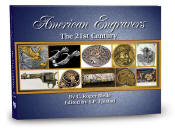
| |
EGG & DART – A type of border motif commonly found in woodwork
moldings but occasionally engraved with Empire, neoclassical, or
renaissance ornamentation. The name is self-explanatory.

|
EICHENLAUBORNAMENT – German-speaking engravers use this term
to describe oak leaf engraving. Engraved oak leaf designs are a popular
motif on German and Austrian firearms though gun engravers of all
nationalities occasionally base designs on oak leaf patterns.
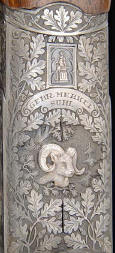
Pictured is the floorplate of a German Merkel double rifle engraved
with an oak leaf or "Eichenlaubornament" motif and inlayed with a
silver ram's head in sculpted relief.
|
EJECTOR ROD HOUSING – Found on revolvers of the Colt Single
Action Army, Lightening, and 1878 Frontier pattern. The ejector rod
housing is attached to the right side of the barrel and encloses the
ejector rod and its return spring. Engraving is usually applied to this
component along with other parts of the revolver.
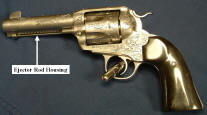
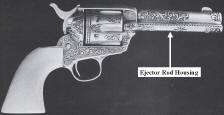
Pictured are ejector rod housings as seen from the left on a Ruger
Vaquero engraved by Roger Bleile and from the right on a Colt SAA
engraved by Bill Johns.
|
EJECTOR ROD SHROUD – Found on some double action revolvers, the
ejector rod shroud encloses and protects the ejector rod except for an
opening on the left that allows the ejector rod to swing out with the
cylinder. Another frequently engraved gun component.
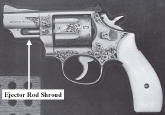
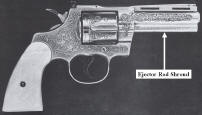
In the pictures, an ejector rod shroud is shown from the left on a
Smith & Wesson Combat Magnum engraved by Carl Bleile and from the right
on a Colt Python engraved by Bill Johns
|
ELBOW – The backbones of scroll ornamentation should be engraved
in a smooth, concentric fashion. Engravers, to describe a scroll that
lacks concentricity because of a portion that is unintentionally out of
round, use the term “elbow”. “Elbows” are frequently found in the work
of beginners due to poor design, lack of tool control, or both.

In the picture, an elbow can be seen in the engraved scroll.
|
EMBOSS – To raise or represent (surface designs) in relief or to
decorate (a surface) with raised ornament. Embossing is a term more
often used by steel die engravers than decorative engravers.

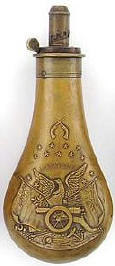
Pictured are two antique powder flasks that have been decorated with
die embossed motifs.
|
EMPIRE - Of, relating to, or characteristic of a neoclassic
style, as in the decorative arts, prevalent in France during the first
part of the 19th century. Related to the First Empire of France
(1804-1815). Characterized by the use of delicate but elaborate
ornamentation imitated from Greek and Roman examples or containing
classical allusions, bas-reliefs of classical figures, motifs of
wreaths, torches, caryatids, lyres, and urns and by the occasional use
of military and Egyptian motifs.
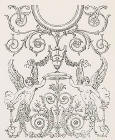
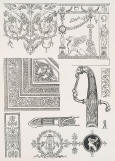
Illustrated are illustrations of Empire ornamentation.
|
ENCHASING – See:
CHASE/CHASING
|
ENG. or ENGR.- English speaking engravers normally use
the abbreviation ENG. or ENGR. meaning “Engraver” after their name when
signing their work.
|
ENGLISH FINE SCROLL, ENGLISH FINE, FINE SCROLL, or
SMALL SCROLL – A type of scroll decoration made popular in the
19th century by the London and Birmingham gun trade. Characterized by
small (about 5 mm more or less) spirals having internal leaves, one
next to the other and resembling a chambered nautilus. English scroll
is now found on guns and knives internationally. Italian: Inglesina,
German: Altdeutscher Arabesken.
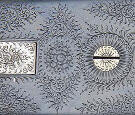
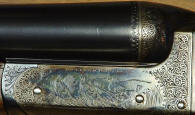
Shown are two illustrations of English scroll. At left is the
floorplate of a London made Purdy engraved with their propriatery "fine
scroll" and at right is the side of a Roland Watson engraved with
English scroll in Birmingham, England.
|
ENGRAVE/ENGRAVING – As used by freehand engravers, this term
means the cutting of a design or motif into metal with a graver,
chisel, or, burin. It is not used to describe the decoration of
nonmetal objects such as wood, ivory, stone, or horn. These items are
carved, scrimshawed, or sculptured. Note: Firearms and edged weapons
decorated with mass production methods such as roll stamping, acid
etching, photo etching, or laser etching are often referred to as
“engraved.” In some cases this use of terminology is caused by
generalization, but sometimes it is an attempt by a vendor to mislead a
potential purchaser. Since hand-engraved pieces are almost always more
valuable than the same items decorated by mass production methods,
buyers should be certain of what they are buying. Some hand-engravers
do however use acid etching or other processes in combination with hand
engraved ornamentation to achieve special effects.
Though some hand engravers are equipped and experienced in engraving
almost anything made of metal, most tend to specialize in one or two
particular sub-specialties of the trade. The following is a list of
hand engraving specialties:
· Awards; trophies, plaques, loving cups, and award jewelry (mostly
done by machine today unless very high end)
· Custom car parts and motorcycles; on cars the engraved parts are
usually engine parts and running gear but on
motorcycles all metal parts including the engine, battery box, tanks,
light housings, fenders, and wheels
· Custom knives and edged weapons; Bowies, daggers, folders, hunters,
skinners, swords, and tomahawks
· Dies and hobs; for striking coins, insignia, and medals
· Intaglio printing plates; banknotes, currency, and fine art prints
· Flatware and hollowware; silver spoons, knives, forks, serving
pieces, tea sets, cups and bowls
· Guns; the metal parts of muskets, pistols, revolvers, rifles, and
shotguns
· Heraldry; coats of arms, crests, and signets
· Jewelry (both fine and craft); bracelets, brooches, earrings,
pendants, and rings
· Musical instruments; brass instruments and the metal parts of banjos,
guitars, and mandolins
· Watch cases; pocket and wrist watches
· Western bright cut silver; bits, buckles, conchos, jewelry, saddle
and tack mounts, and spurs
|
ENGRAVE-IN – An annual event conceived and hosted by engraver
Scott Pilkington and located near Monteagle, Tennessee. Each year since
2007, hand engravers meet at the Engrave-In to discuss techniques, hold
seminars and display their work in a casual atmosphere without the
pressure of selling or customers.
|
ENGRAVER – One who engraves metal with a burin or chisel.
French: Graveur, German: Graveur, Italian: Incisore. Also see HAND
ENGRAVING.
|
ENGRAVER’S BLOCK – A special vise used by hand engravers. The
block is usually spherical, with adjustable jaws on top and usually
sits in a felt, leather, nylon, or rubber ring. Known in earlier times
as an “engraver’s bullet.” Italian engravers refer to the block as "morsa
da tavolo" (table vise). German speaking engravers call the block the "graveurkugel."
In French "etau a boule." Also see BLOCK for illustrations.
|
ENGRAVER’S BULLET – An archaic name for an engraver’s block.
|
ENTWINING LINE MOTIF – A design, either engraved or inlayed,
which uses two or more lines that alternately separate and converge in
a uniform manner.




Pictured are examples of entwining line motifs, both inlayed and
engraved.
|
ESCUTCHEON - A shield or shield like surface on which a coat of
arms is depicted. An escutcheon can also be an ornamental medallion
inlayed into a gunstock, forend, pistol grip, or knife handle.

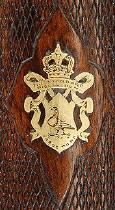
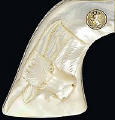
Pictured are a forend tip escutcheon, a gunstock escutscheon, and an
escutcheon inset into a Colt revolver grip.
|
ETAU a BOULE – French: Literally, vice ball. A “block” or
engraver’s block.
|
ETCH - To produce a design, especially on metal or glass, by the
corrosive action of acid. In arms embellishment, etching is sometimes
used in conjunction with engraving in order to achieve a special effect
on the background or finish of the metal. This practice is entirely
acceptable and even desirable in some cases. Most advanced arms
collectors, however, avoid those pieces entirely decorated by etching
from set patterns, because such decoration is a form of mass
production. There are, however, a small number of artisans who do one
of a kind etching on knives for collectors.


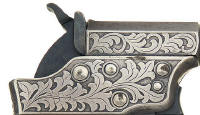

Pictured are four examples of etched decoration on various arms. The
reader will note the distinctly different appearance of etching from
the examples of hand engraving seen elsewhere on this site.
|
EUROPEAN METHOD or TECHNIQUE – Also known as the “side-hand
method”, is a technique of engraving with hammer and chisel. Most H&C
engravers in Europe and the Americas use this technique. In this way of
engraving, the engraver holds the chisel in his weak hand, palm down,
with the cutting tip on the same side as his or her little finger and
the butt of the chisel on the side closest to the thumb. The hammer is
held in the strong hand and is used to tap the butt of the chisel while
cutting. Compare with ASIAN METHOD.
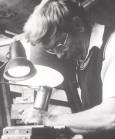
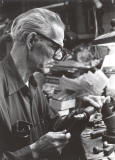
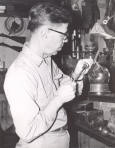
Pictured are three American engravers, each using the "European" or
"side hand" engraving method. From left, the late Frank Hendricks of
Texas, the late Floyd Warren of Ohio, and the late John Warren of
Massachusetts.
|
|